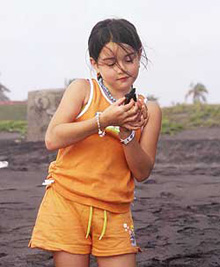 |
 |
 |
 Travel & Outdoors | April 2007 Travel & Outdoors | April 2007  
Discovering Mexico's Endangered Tortugarios
 Judi Lees - Vancouver Courier Judi Lees - Vancouver Courier


| | A girl holds a baby turtle before it begins its journey to the sea. (Judi Lees) |
Cuyutlan, Mexico - Before a recent visit to the Pacific coast of Mexico, I had thought little about turtles. Now, I am enchanted by them.

It began in the small state of Colima. We left the busy tourist hub of Manzanillo and drove southeast to Cuyutlan. Well-known to surfers thanks to the pounding surf on black-sand beaches, this sleepy village is a pleasant place to spend time. We lunched at Hotel San Rafael and admired its sun-drenched playa before driving a bumpy road to El Tortugario Ecological Centre.

Here, thanks to a knowledgeable guide, Rafael Robles, and an interpreter, we learned about tortugarios - turtles, to us. Five endangered species are found on the Mexican coast.

Along this beach, conservationists protect some 900 nests. From August to November, female turtles trundle ashore at night to lay between 50 and 100 golf-ball-size eggs in a sandy nest. After 45 days, tiny newborns work their way through the soil. The turtles are threatened by predators such as crabs, birds, fish and sharks, as well as poachers who sell the eggs, believed to be an aphrodisiac. Even with a devoted following of conservationists who protect the nests and release turtles, only about one per cent of the turtles survive.

At Cuyutlan I picked up sleepy-eyed turtles and sent them towards the sea. It seemed incredibly brave for them to walk into the Pacific Ocean after just emerging from a cozy nest. Here's the ritual: we turtle releasers stand behind a line drawn in the sand; you take one turtle at a time and send it off towards the ocean. There is always a dominant turtle that quickly - well quick for a turtle - leads the way. Once on the sand, a chemical process called "imprinting" takes place; they memorize this sandy beach and, should they be fortunate enough to reach maturity some 15 years later, they will return here.

Later, I spent time in Melaque. This small town north of Manzanillo doesn't have a time-share in sight and is loved by those who prefer the real Mexico with dusty streets and small shops and restaurants. On an evening beach stroll my husband and I happened upon a group of turtle savers at San Felipe Hotel. A Canadian, Felipe Saunier, who owns the hotel along with his Mexican wife Linda, heads up a group of volunteers intent on saving turtles.

Melaque's sweeping arc of beach along Bahia de Navidad has been devoid of turtles for decades because, before laws were passed, turtles were a mainstay of the locals' diet. Now, eggs gathered from a nearby beach are reburied within a protected compound on the ocean side of San Felipe Hotel.

Here's the warm, fuzzy ending to this turtle saga. One night during the week I visited, a female turtle arrived on the beach in front of the hotel. She was spotted by a local, who woke up Felipe, who watched her lay her eggs and then head back into the ocean.

"We're told it's the first turtle [on our beach] in about 20 years," said Felipe, with a huge grin, the next morning.

If You Go:

To learn more about the San Felipe Hotel's turtle program visit its website at www.hotelsanfelipe.com.

For information on travel in Mexico visit the Mexico Tourism Board website at www.visitmexico.com. | 
 | |
 |



